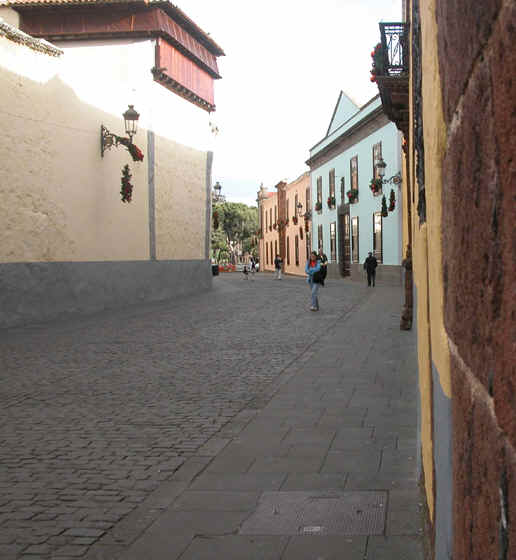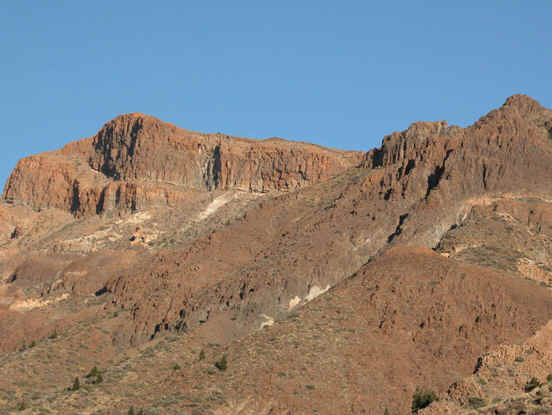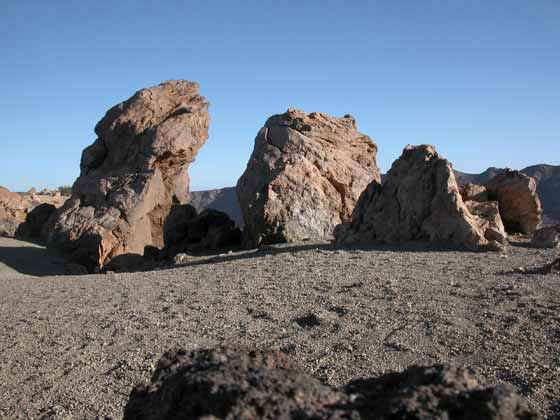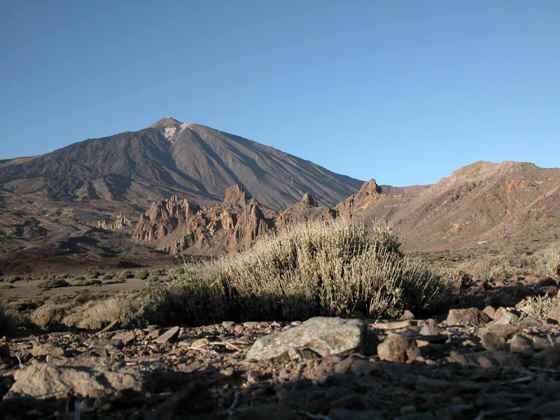
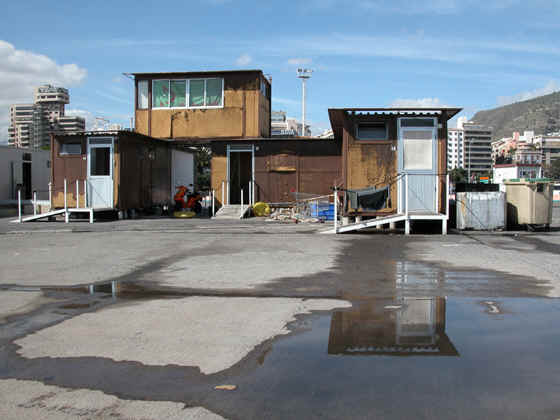 |
Santa Cruz de Tenerife, where to start.
Well let's start with Marina del Atlantico, which was to be our home for
the next three months. The pilot (2004) mentions the "extremely dilapidated
services building" and that it is due to be replaced by
August 2004. This photo was taken in 2007 and as you can see the word
"building" is clearly used in a poetic sense - and it hasn't been
replaced. The mariņeros' office is on
top!
Whilst you are looking at this picture you should be aware that once the three sets of "taxes" (harbour tax, lights tax and recreational tax) are added to the bill, Marina del Atlantico is more expensive for the winter than Barcelona, which probably means it's the most expensive winter marina in Spain. To avoid any doubt - Santa Cruz is NOT Barcelona. (More like a slightly warmer version of Swansea.) Below is one of the views from Samarang. You will be told by the marina staff that the "taxes" are due at every marina in the Canaries and sailors passing through take this at face value, and pass through as quickly as possible. In fact the "taxes" do not exist at any other marina, nor have they been heard of on any other island. They don't even exist in the two other marinas six miles either side of Marina del Atlantico. The others are of course full and well maintained, whilst Atlantico is half empty (once the December rush is over) and has unrepaired pontoons from storms 2 years ago! |
|
| Well, we'd paid upfront for three
months, taxes and all, and we couldn't get our money back so we set about
getting on with our lives. Our first priority was to find a language
school. We were committed to putting all our normal winter boat jobs
on the back burner for the first month or so and focusing on our
Spanish. This turned out to be more difficult than we had
imagined. After extensive searching of the net, visiting the tourist
office and library we were only able to find one school. Having
limited options we signed up for 4 weeks.
It was dreadful. We took the level test and were assessed as 'intermediates'; given the appropriate books and shown to our classroom, where two German girls were already studying. Ivan, the teacher, took our books away and returned with elementary books. We spent the next three hours conjugating the verb "to be". Revision is always a good thing, but.... The next morning we arrived early for a frank discussion with Ivan. He agreed that the level was too low, but they didn't have an intermediate class. He assured us that next week would be better, after the German girls left. Things now got worse, Ivan started leaving the syllabus to have conversations with us at a level that was incomprehensible to the girls (for whom we felt truly sorry). Additionally the method of language teaching was decades out of date, the sort of grammatical approach that one sees in the Latin classes of films about English public schools in the 19th century. |
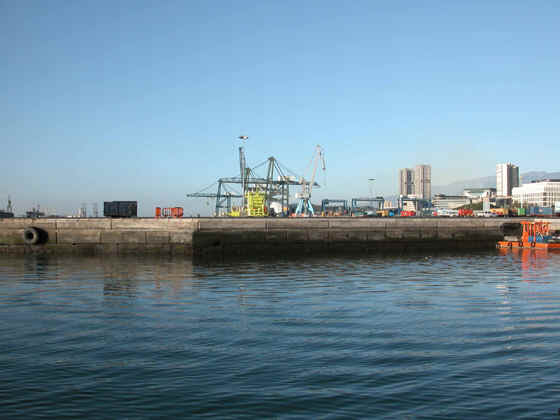 |
|
| Enough was enough! We paid for a week and left. And then we found Cristian - an (almost) unemployed Argentine journalist. He came to us on the boat each morning with topical material that he'd downloaded the previous night, for comprehension and discussion. He developed role plays with us which related to real life - a telephone conversation with a sailmaker or a complaint in the Vodaphone shop about our still faulty UMTS card. Learning Spanish once more became fun as well as useful. | ||
|
|
So
for the next four weeks studying Spanish occupied most of our time,
but we did take a trip up to La Laguna, which was the original island
capital. It is considered to be the first colonial town on which, many
South American cities were modelled (notably Cartegena de Las Indias in
Columbia) and is now a UNESCO World Heritage Site. Well, it certainly
has a pleasant enough old town, particularly when compared to Santa Cruz
de Tenerife, but
having visited a few other W.H.S.s it is hard to see quite why it justifies
that classification. One has the
feeling, that in the beginning, UNESCO classified the very best and most
important sites, and after that the slightly less important, etc,
etc., which is a shame because it devalues the point of what seemed
an important concept.
And then it was Christmas. A pretty quiet affair this year as all the cruisers had now left and the marina was virtually empty. The highlights had to be the free classical Christmas concert for which the main car park next to the marina had been closed for weeks to allow the installation of a covered stage and terraced seating for 10 thousand. At midnight, as soon as the concert ended, we dashed back to the boat for the firework display which was set off from the harbour wall not much more than a hundred yards from where we were berthed. |
|
| The next event of note was the arrival of Rob and Kate from Rota for a long weekend. Out to dinner with some of their Canarian clients - an opportunity to put our Spanish to the test - then a flying tour of the island. Importantly they also stocked us with huge quantities of their tortilla chips. | ||
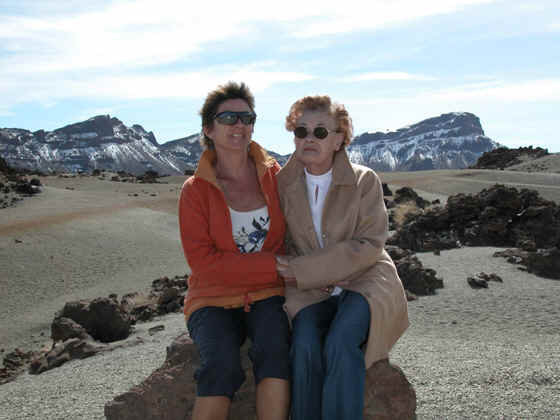 |
And then a week later Lindy's mum, Audrey, came to visit for a few weeks. We had deliberately waited for her arrival before doing too much sight-seeing and now hired a car to explore the island. Santa Cruz has its shortcomings and the tourist resorts on the south of the island are not to our taste, but the scenery in the interior of the island is truly fantastic. It ranges from the cloud-enveloped forests in the north to the lunar volcanic landscape surrounding Mount Teide in the centre. Teide itself is Spain's highest mountain and is often snow- capped in spite of the temperature on the coast. More pictures below - |
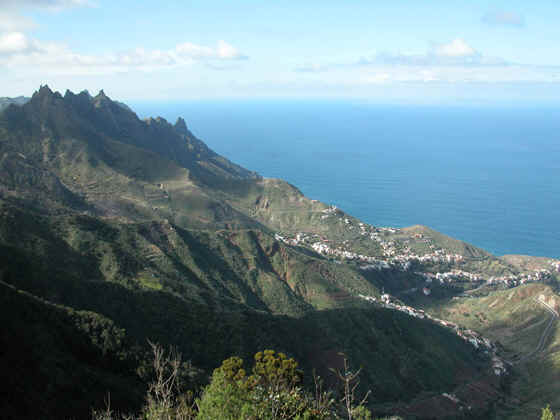 |
| Once Audrey returned to the UK
we still had a few days before we were due to lift Samarang, with a list
of jobs to complete before we left the Canaries. As luck would have
it this coincided with our friends Sue and Philip visiting other mutual
friends Steph and John, (some readers will remember we last bumped into
them in Pompeii) who had taken an apartment in Los Cristianos.
Los Cristianos, well what can we say. We'd made a quick visit there a week or so previously to view the boatyard facilities, and chose to stay in the boatyard cafe overlooking the harbour for lunch. Los Cristianos exists solely for the tourists, who you will find neatly packed in rows around the pools of the hotels and apartment blocks or on the numerous golf courses carved out of the desert and constantly sprinkled with water produced in the energy hungry desalinisation plants along the coast. In Los Cristianos, and its relatives along the coast, you can come for your few weeks of sun without ever being troubled by the sound or sight of the Spanish language, or of having to risk tasting Spanish food, which is fine if all you want is a couple of weeks in the sun. MacDonald's and Kentucky round every corner, as well as, what I think I'm safe in saying is, the worst Chinese food I have ever eaten - Let's be clear here soggy/crispy duck and tinned mango slices do NOT go together. And if you did wake up one morning with a weird desire to put mangos with duck, well they grow fresh on Tenerife all year round for goodness sake. That there is a demand for this kind of holiday is beyond doubt, and with 65% plus of their GDP coming from tourism it is a demand that the Canarians are happy to service - particularly since they had no other use for the desert in the south of the island anyway. That's how free market economics works and we are big fans of the free market. I suppose if we worked in a factory in Birmingham all year we might feel differently, but we now have too many weeks in the sun and for ourselves need to look for something more. For us it was great to meet our friends and we would have liked to spend more time with them. Still could have given the duck and mango a miss though! |
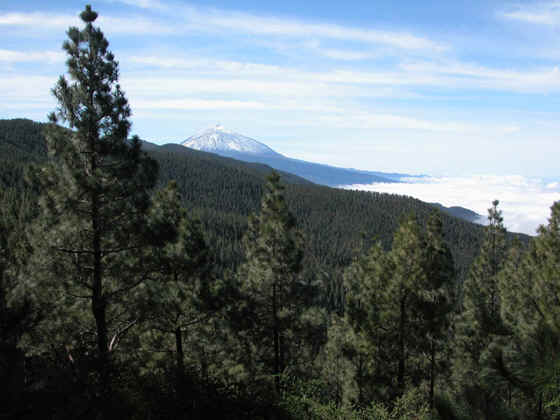
|
We must also of course mention
Carnival - though we were too busy enjoying it to take any photos. Santa Cruz (along with Venice, Cadiz and probably several
other places) claims to be the second best carnival in the world after
Rio. It actually feels almost like three different carnivals: There
is the week-long Murga's competition - think fifty guys in outrageous
costumes, singing barber shop harmony, accompanied by kazoos. It has
to be said that this description doesn't really do it justice, though the kazoos
do get a bit monotonous. To appreciate Murga's you really do need a
good understanding of Spanish (ie better than ours) as they are mostly
highly political and deeply satirical - this year's common theme (and
possibly every other years' as well) being corruption in local government
- a traditional Canarian pastime!
Then there's the competition to choose Queen of the Carnival. This is less a beauty pageant and more a design and engineering competition, as the girls are all but invisible within the structure that will form their float. This has to be, in spite of its proportions, light enough for them to move/drag around the stage in a vaguely elegant way as they stand inside it. Actually that should read ' Queens' in the plural. As well as the queen proper there is a competition for children, a competition for ladies of the "third age" (what we used to call old folk) and then of course there's the drag queen (possibly the most sensational) . All of the queens and murgas competitions go on for a couple of weeks and are televised, but the third part of Carnival, the real part if you like, starts when these are completed and goes on for another week - this is on the street. All the queens and murga bands at some point make it out onto the street, but so does everyone else. Anyone who has a truck or a van, builds a float. These range from the spectacular, to half a dozen neighbours in a van with some booze and a ghetto blaster - though the latter are in the minority. As well as the floats there are troops of dancers and, even if you are not involved in any of these things, you still dress up. You need to understand (if you've never experienced it) this isn't just a procession, it's everywhere - every bar, every square, every street corner. Drag is huge and, putting to one side the guys for whom this is a way of life, seems to be especially favoured by bearded men. You could be forgiven for thinking that you'd woken up in the annual meeting of the Kenny Everett fan club. The whole thing goes on all week, every night, all night until dawn. One of the most memorable things is the good-nature that prevails. Copious amounts of booze are consumed, and by the end everyone must be exhausted, but we saw no sign, nor read any reports, of any violence or any problems of any kind. The closest ever experienced to this in terms of citywide general drunken friendliness was hogmonay in Edinburgh. |
| But before Carnival was over it
was into the boatyard for us. Everything carefully choreographed so
that we'd be back in the water within 10 days! Actually, of course,
we were on the hard for a month.
One of the major tasks was to cut out some rust in the anchor locker that had come through the bow and weld in new plates. None of the repainting, etc could start until the welders had finished. The welding was being done by the local fisherman's co-operative, clearly their raison d'etre was repairing fishing boats and we knew that if a fishing boat had a problem all hands would be diverted to that. In fact the welding was finished two days after we lifted. If anyone from Manoel Island yacht yard is reading this: that's 2 men, 2 days - not the 2 man weeks that you quoted! |
||
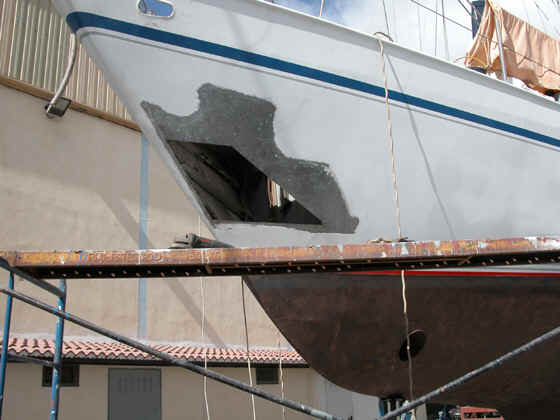 |
After that, of course, everything else started to slow down. As well as repainting the repairs and having another go at fixing the perennial leak from our hydraulic steering, we were replacing the exhaust system. We'd recently replaced a corroded exhaust bend and discovered that the tubing carrying the exhaust out of the boat was only about 50% of the diameter that the engine required. Jobs like this, which require feeding extremely unmanageable tubing and piping through the bilges are notoriously time consuming, and it certainly cost us a few days. Though with technical input and skill provided by Rafa, our Venezuelan Mechanic/Hydraulics technician (pictured on the right), and dirty, brute force plumbing work performed by Barry we got it done. But what really slowed us down was repainting the bow. It was a simple enough job. repaint inside the locker, fill and spray the bow. Three or four days work, but not if it has to be done three times. In the end we opted to put the boat back in the water, even though the paintwork was still sloppy. The alternative seemed to be to plant a flower bed around the boat, like on a residential caravan site and face the fact we'd never leave - Varadero Anaga was beginning to feel just a bit like Royston Vasey!
|
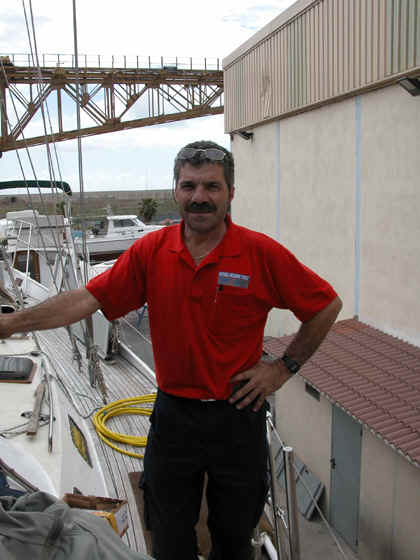 |
| So back in the water we went and
motored back to Santa Cruz. On a positive note, our new exhaust had
given us an extra knot of boat speed, the steering leak had finally been
cured, and we couldn't see the paint on the bow from the cockpit.
So we were ready to leave - except for some niggling discomfort in one of my teeth. It is, of course, coming from beneath a double crown...... We go to see the dentist, Dr Polo, who x-rays and identifies a problem with the original root canal work. We're sent with the photo to a consultant endodentista who says the crown must come off. Back to Dr Polo the following day. After 2 hours plus of hammering and vibrating inside my head, the crown remains stubbornly in place. I joke in bad Spanish that normally all that's required is to chew some sticky toffee. This receives blank looks so obviously something was lost in translation - or maybe it's just not very funny. Dr Polo now explains (in perfect Spanish and bad drawings) that it will be necessary to cut the (very expensive) crown. Another hour later and I leave minus half a double crown. Next day we return to the endodentista Dr Alventosa - who we have discovered is ex-president of the Spanish Association of Endodentistas - so I'm in good hands. After about 2 minutes, he assesses my Spanish as too painful to bear and switches over to faultless English. This is a relief as patient - dentist conversations are always difficult, since patient normally has mouth full. He explains that this will be a very difficult procedure (oh bliss). He first has to gain access to the root canal and then overcome whatever obstacles the other "professional" has created - his quotation marks! 2 hours and many x-rays later Dr Alventosa is finally satisfied ( the same cannot be said of his other patients who have been waiting behind me!). Alventosa promises to call me the following day to check I'm OK, which he does - and not "call me if there's a problem". Then we need to return to Dr Polo for the relatively routine job of making and fitting a new crown, though with the addition of a carbon fibre peg, there now being so little actual tooth left. As a postscript to this story, some weeks letter when we're leaving for La Gomera I'm still experiencing slight discomfort and I'm worried about setting off into the Atlantic with a potential problem. So I call Dr Alventosa's office and he calls that evening to spend 10 minutes discussing the problem and putting my mind at rest, which was really helpful. Then a week later, when we were in La Gomera, out of the blue he called again just to check that all was OK. He also gave me his e-mail address should I need to contact him in the future - " even from mid Atlantic, though in that case I will only be able to provide moral support". I mention this because I think of it as really exceptional patient care. You'll have gathered from the last paragraph that we did finally leave Santa Cruz. We sailed down the east coast and spent a few days anchoring (and re-anchoring) in a few of the bays as we tried to come to term with the fluky winds that eddy round the corners of the island. These make some of the bays a wind and kite-surfing paradise, but not necessarily a tranquil anchorage. We had one kite-surfer jump over the stern of the boat whilst we were sitting in the cockpit. I don't think he'd spotted the forest of antennas on our targa arch until the last minute, but he still made it with a smile.We took the opportunity to try out our new and now modified anchor. It absolutely, 100% failed to set in beautiful sand. In spite of multiple attempts it lay stubbornly on its side, making no attempt to dig in and happy to be dragged around the bay all day. Eventually Lindy had had enough, hauled it up, then put the Bruce back on. We have one final modification to attempt before it goes to join Davey Jones on a permanent basis. |
||
